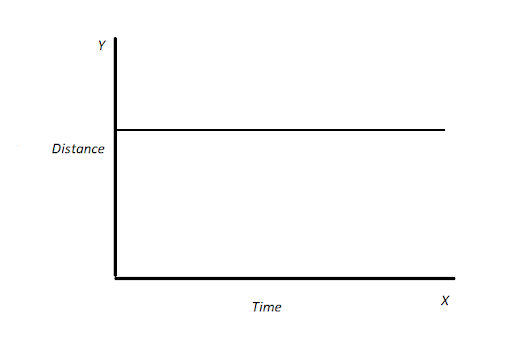
Assertion: The position-Time graph of a stationary object is a straight line parallel to the time axis.
Reason: For a stationary object, the position does not change with time
A. Both Assertion and Reason are correct and Reason is the correct explanation for Assertion.
B. Both Assertion and Reason are correct but Reason is not the correct explanation for Assertion.
C. Assertion is correct but the reason is incorrect.
D. Both Assertion and Reason are incorrect
Answer
217.8k+ views
Hint: This question basically is a concept from Motion in one dimension. In the question given above, consider the graph of position vs time where the slope is zero and the object is stationary.

Given graph is position vs time which shows a straight line parallel to the time axis. In the concept of graph theory for different conditions of stationary objects, we basically calculate the slopes for the given graphs and watch the different aspects of the position of the objects with respect to the time.
Formula used:
\[m = \dfrac{{{y_2} - {y_1}}}{{{x_2} - {x_1}}}\] ,
Using the above formula, we can calculate the slopes for the graphs.
Complete step by step solution:
The given statement says that the position vs. time graph for a stationary object is basically a straight line parallel to the time axis. The stationary object is nothing but the simplest motion for any object to perform, basically, a stationary object does not move and the position of the object does not carry or change from its original location.
Therefore, the gradient m or the slope can be calculated for the given graph by dividing the change in the dependent variable y by the independent variable \[x\]. It’s given as:
\[m = \dfrac{{{y_2} - {y_1}}}{{{x_2} - {x_1}}}\]
Gradient or slope for the position vs time graph gives average velocity which comes out to be 0 m/s since the stationary object does not change its position.
Hence, option A is the correct answer.
Note: Make sure you are calculating the slopes for the graph as per the required constraints and studying the different nature of the graphs and analysing it. When the object that is being considered is at rest, then its position will not change with time.

Given graph is position vs time which shows a straight line parallel to the time axis. In the concept of graph theory for different conditions of stationary objects, we basically calculate the slopes for the given graphs and watch the different aspects of the position of the objects with respect to the time.
Formula used:
\[m = \dfrac{{{y_2} - {y_1}}}{{{x_2} - {x_1}}}\] ,
Using the above formula, we can calculate the slopes for the graphs.
Complete step by step solution:
The given statement says that the position vs. time graph for a stationary object is basically a straight line parallel to the time axis. The stationary object is nothing but the simplest motion for any object to perform, basically, a stationary object does not move and the position of the object does not carry or change from its original location.
Therefore, the gradient m or the slope can be calculated for the given graph by dividing the change in the dependent variable y by the independent variable \[x\]. It’s given as:
\[m = \dfrac{{{y_2} - {y_1}}}{{{x_2} - {x_1}}}\]
Gradient or slope for the position vs time graph gives average velocity which comes out to be 0 m/s since the stationary object does not change its position.
Hence, option A is the correct answer.
Note: Make sure you are calculating the slopes for the graph as per the required constraints and studying the different nature of the graphs and analysing it. When the object that is being considered is at rest, then its position will not change with time.
Recently Updated Pages
Arithmetic, Geometric & Harmonic Progressions Explained

Cartesian Form of Vector Explained: Formula, Examples & Uses

Apparent Frequency Explained: Formula, Uses & Examples

Calorimetry: Definition, Principles & Calculations

Centrifugal Force Explained: Definition, Formula & Examples

Charge in a Magnetic Field: Definition, Formula & Examples

Trending doubts
JEE Main 2026: Application Form Open, Exam Dates, Syllabus, Eligibility & Question Papers

Derivation of Equation of Trajectory Explained for Students

Hybridisation in Chemistry – Concept, Types & Applications

Understanding the Angle of Deviation in a Prism

Understanding Collisions: Types and Examples for Students

How to Convert a Galvanometer into an Ammeter or Voltmeter

Other Pages
JEE Advanced Marks vs Ranks 2025: Understanding Category-wise Qualifying Marks and Previous Year Cut-offs

Units And Measurements Class 11 Physics Chapter 1 CBSE Notes - 2025-26

NCERT Solutions For Class 11 Physics Chapter 8 Mechanical Properties Of Solids

Motion in a Straight Line Class 11 Physics Chapter 2 CBSE Notes - 2025-26

NCERT Solutions for Class 11 Physics Chapter 7 Gravitation 2025-26

Understanding Atomic Structure for Beginners




